Struggling readers - Eye movement activities for children who are finding reading challenging
Reading words and letters on a page starts with being able to stabilise the head while moving the eyes. This skill starts with the visual and vestibular systems, that we learn from birth, not from a book.
Visual tracking is the ability of the muscles of the eyes to follow a moving object, to look from one object to another, and to stare and focus at a stationary object.
Visual tracking involves two key movements:
- Visual smooth pursuit (scanning the eyes left, right, up, down and in a circle)
- Visual saccades (jumping the eyes to focus from one object to the next object)
Visual pursuit refers to both the left and right eye moving smoothly, from left to right, right to left, up to down and down to up, as well as moving smoothly with both eyes working together in a diagonal and rotational direction.
Visual saccades refers to both of the eyes focusing on an image in one location (for example, to the left of the body), then quickly moving/jumping the focus to another image in a different location (for example on the right hand side of the body).
An example of visual pursuit is watching a tennis match where the eyes need to follow the movement of the ball from one side of the tennis court to the other, without losing focus of the ball.
An example of visual saccades is looking at your teacher in the room and then quickly focusing back onto your work in front of you.
Visual tracking is one of the first movements that a baby learns to coordinate as they look up towards their caregiver during each feed, and then look around the room as they hear their caregiver's voice from across the room.
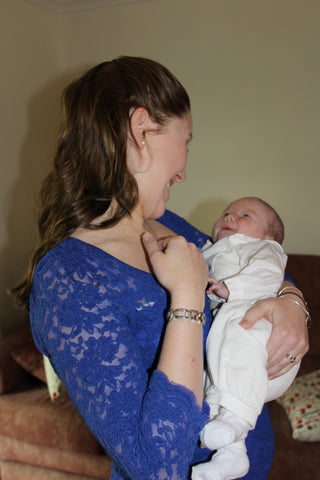
In my role as a paediatric Exercise Physiologist, I see a number of children, particularly since the introduction of screens and electronic devices, struggling with the coordination of their eyes both with visual pursuit movement and saccadic movement.
Children may be struggling with visual pursuit coordination over the last few years due to increased screen time, because the eyes don’t need to move and focus at long distances from left, right, up and down, as you can see all of the information on the smart device in one gaze when playing on a screen.
Similarly, children may be struggling with visual saccades because the eyes don’t need to jump a significant distance from one side of the body to the other when playing on a smart device that is usually positioned in the middle of your body.
While I don’t want to pick on screen time, and I want to acknowledge that my own children enjoy video games and screen time. I feel that it’s important to set healthy boundaries with screens, and have a healthy balance of screen time and physical activities that will make sure that children build up all of the motor skills that they need for learning and life, because screen time:
- Reduces children's head movement - which reduces vestibular stimulation
- Reduces children's visual tracking and eye movement
- Reduces children's opportunity to improve core strength and coordination
It’s important to note that visual tracking is not a skill that comes naturally for us. Visual tracking is a skill that we need to practice, just like being able to throw and catch a ball, hop on the spot, crawl, etc.
I wanted to give you some tips on how we can improve visual tracking at a time that I know that a lot of our children are on screens (mine included).
Why visual tracking is important
Imagine the visual tasks of a typical day at school. Children need to be able to:
- Scan their eyes from left to right across the page of a book without losing where their position is on the page
- Jump their eyes from one word to the other, without becoming distracted by the spaces between the words
- Look up at the notes on the whiteboard, then look down to write on the piece of paper in front of their body, without feeling dizzy or lose focus for where their eyes and moving to and from
- Track their teacher’s movement smoothly from left to right, and right to left as the teacher moves in the classroom
- Coordinate the movement of their eyes without losing their balance when playing a game with their friends at lunch time
- Adapt the focus of their eyes as they move from reading a book up close indoors, to following the movement of a ball across larger distances outdoors
If children are feeling tired by the constant movement and focus of their eyes at school, they may become more reluctant to read books in class, and play physical activities with their friends at lunch time.
My goal is to build up their visual tracking and gazing endurance so children can have less fatigue and eye strain at school. Here’s how…
- Follow the pencil topper
- As children are entering the room, ask the children one at a time to follow the movement of the pencil topper as you slowly move the pencil topper towards the left, right, up, and down. You can add in a challenge by also adding in diagonal and rotational directions
- As one child follows the pencil topper for 10 to 20 seconds, then ask the next child to have a turn
- Watch to make sure that the children are coordinating both of their eyes to move smoothly at the same time. If the child has one more coordinated eye than the other, continue to practice this activity at home and consult a behavioural optometrist to further support the child’s visual skills
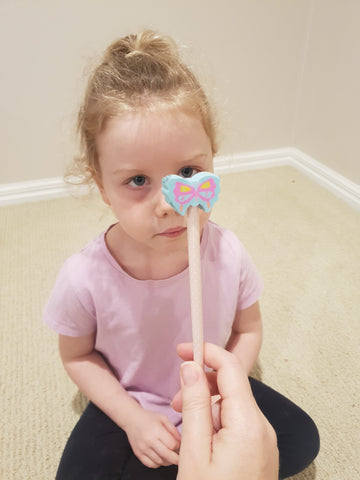
- Hang a ball from the roof using a lady’s stockings or elastic cord, or hold a ball on a string with your hand hand - just above the child's eyebrow height so they need to look up with their eyes - but not too high that the child needs to lift their head up
- Firstly, tap the ball with their dominant hand so the ball on a string moves backwards and forwards
- As the ball gets consistent momentum ask the child to catch the ball with both of their hands at the same time to stop the ball’s momentum
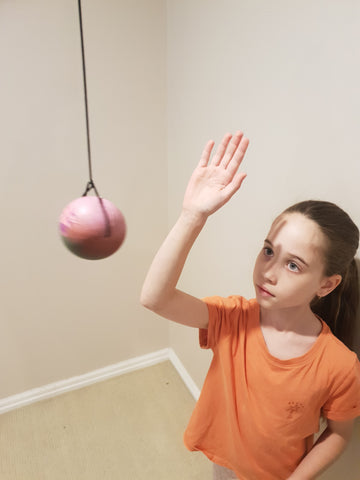
- Climb and play on play equipment for at least 10 minutes each day
- This goal I set for all children, not just active children who engage with the play equipment at recess and lunch time. Because I know my son Hugh had difficulty with his movement and used all of his charming social skills to avoid the play equipment at kindergarten and school, and he really needed to practice this type of movement the most.
- Climbing encourages the head to look up to find the next ladder rung or tree branch to hold on to - Upward gaze is an important skill when looking up at our teacher to listen to their instructions, then look back down at our work without losing focus
- Tap a balloon with the class at the start of the day.
- My daughter’s teacher at the moment uses this strategy every day, where he has a piece of string tied high up across the classroom, and every morning as the children arrive at school they play a game where they tap the balloon 4 times then try to tap it over the top of the string, similar to a game of volleyball.
- Tapping a balloon encourages children to look up, down, left and right in a visual saccade motion. It also encourages other areas of children’s development such as vestibular balance, spatial awareness, core strength, shoulder stabilisation, etc.
- An activity for home involves doing chores - with a dash of fun
- Every week, I help my children to fold the family’s collection of clean socks and my children lay on the ground in a tummy time position and throw the rolled up pairs of socks into a washing basket. If your family are competitive like mine, the person who gets the most socks into the basket wins the opportunity to choose what’s for dinner, or what chore they prefer to do for the afternoon (most of my kids fight over feeding my dogs, versus doing the dishes)
Why we want to find a healthy balance between our children's current screen time and their ability to improve their visual tracking
I feel that screens are hindering children’s visual tracking and hand-eye coordination skills because when we play on a device, their vision (gaze) is looking straight ahead, not like how the eyes are moving when reading.
Furthermore, they're typically looking down at the smart device not upward. Similarly, we aren’t living in a 3D world, throwing and catching a ball back and forth when on video games, so we’re not developing important hand-eye coordination, 3D spatial awareness, and balance skills when on devices.
While I can appreciate that the new lifestyle we have has a strong relationship with devices, and the use of screens are inevitable, I would still like to encourage children to have a healthy balance with play, physical activity and screen time.
Access more activity ideas here
If we think of visual tracking in a way that it's an important skill just like jumping, being able to sit upright, being able to run around with friends, then we need visual tracking activities included in our every day, to help improve children's success with kindergarten, school, and life skills in general.
Tomorrow, grab that pencil and that pencil topper and as children come in to the classroom for the morning, or before children put their shoes on for school in the morning, ask them to look left, right, up, and down following the movement of the pencil topper. Or if your child isn’t interested in this activity, put on a 2 minute timer in the morning or after school and tap a balloon to them in a range of different directions. Whoever misses the balloon jumps, spins, hops 5 times on the spot.
To improve children’s motor skills, it doesn't need to be long physical activity sessions, or doesn’t require specialised equipment. A strategy to start with tomorrow could be 20 seconds of visual tracking a pencil topper or a balloon, then throwing socks into a basket on the weekend.
Small changes in our daily routine to include more movement and play, is a great start to make sure that children progress through their developmental milestones while having fun.
Learn more here


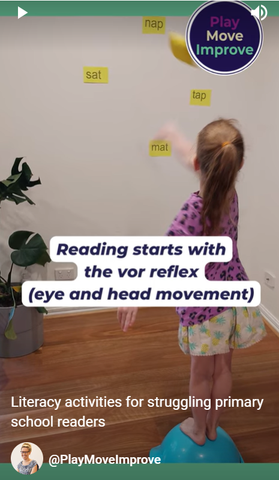
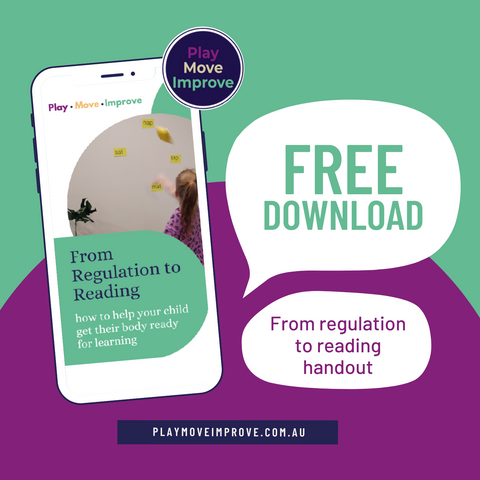
Leave a comment